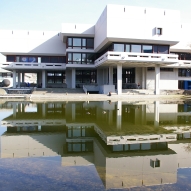| Dokumentenart: | Artikel | ||||
|---|---|---|---|---|---|
| Titel eines Journals oder einer Zeitschrift: | European journal of medicinal chemistry | ||||
| Verlag: | Elsevier | ||||
| Band: | 21 | ||||
| Nummer des Zeitschriftenheftes oder des Kapitels: | 4 | ||||
| Seitenbereich: | S. 333-338 | ||||
| Datum: | 1986 | ||||
| Zusätzliche Informationen (Öffentlich): | CAN 106:264 1-6 Pharmacology 63-91-2; 73-22-3; 673-06-3; 7424-00-2 (4-Chlorophenylalanine); 7635-29-2; 33522-63-3 (3,4-Methylenedioxyphenylalanine) Role: BIOL (Biological study) (diamine deriv. prepn. from); 102050-52-2P; 105236-99-5P; 105237-00-1P; 105237-01-2P; 105237-02-3P; 105237-03-4P; 105237-04-5P; 105237-05-6P; 105237-06-7P; 105237-07-8P; 105237-08-9P; 105237-09-0P; 105237-10-3P; 105237-11-4P; 105237-12-5P; 105237-13-6P; 105237-15-8P; 105237-16-9P; 105266-53-3P; 105266-54-4P; 105308-31-4P; 105368-95-4P; 105709-39-5P Role: BAC (Biological activity or effector, except adverse), BSU (Biological study, unclassified), SPN (Synthetic preparation), THU (Therapeutic use), BIOL (Biological study), PREP (Preparation), USES (Uses) (prepn. and antitumor activity of); 5429-22-1P; 41888-62-4P Role: RCT (Reactant), SPN (Synthetic preparation), PREP (Preparation), RACT (Reactant or reagent) (prepn. and hydrolysis of); 53707-84-9P; 75543-73-6P; 85612-59-5P; 85612-60-8P; 104907-20-2P; 104907-21-3P; 104907-22-4P; 104907-23-5P; 104907-24-6P; 104907-25-7P; 104936-00-7P; 104975-45-3P; 121326-70-3P Role: RCT (Reactant), SPN (Synthetic preparation), PREP (Preparation), RACT (Reactant or reagent) (prepn. and reaction with tetrachloroplatinate); 21542-84-7P; 38243-40-2P Role: RCT (Reactant), SPN (Synthetic preparation), PREP (Preparation), RACT (Reactant or reagent) (prepn. and redn. of); 6318-39-4P; 76605-42-0P; 89939-28-6P; 104907-18-8P Role: RCT (Reactant), SPN (Synthetic preparation), PREP (Preparation), RACT (Reactant or reagent) (prepn. and reductive hydrolysis of); 2021-58-1P; 5472-67-3P; 63701-37-1P; 104907-19-9P Role: SPN (Synthetic preparation), PREP (Preparation) (prepn. of and diamine derivs. prepn. from); 120-57-0 (3,4-Methylenedioxybenzaldehyde); 123-11-5 (4-Methoxybenzaldehyde) Role: RCT (Reactant), RACT (Reactant or reagent) (reaction of, with acylglycine derivs.); 461-72-3 (Hydantoin) Role: RCT (Reactant), RACT (Reactant or reagent) (reaction of, with aldehyde derivs.); 495-69-2; 543-24-8 Role: RCT (Reactant), RACT (Reactant or reagent) (reaction of, with benzaldehyde derivs.); 98-03-3; 454-89-7 (3-Trifluoromethylbenzaldehyde); 6287-38-3 (3,4-Dichlorobenzaldehyde); 82772-93-8 (2,6-Dichloro-4-methoxybenzaldehyde) Role: RCT (Reactant), RACT (Reactant or reagent) (reaction of, with hydantoin) | ||||
| Institutionen: | Chemie und Pharmazie > Institut für Pharmazie > Entpflichtete oder im Ruhestand befindliche Professoren > Prof. Schönenberger | ||||
| Identifikationsnummer: |
| ||||
| Stichwörter / Keywords: | Neoplasm inhibitors (ethylenediamine platinum complexes) ethylenediamine platinum complex antitumor prepn | ||||
| Dewey-Dezimal-Klassifikation: | 500 Naturwissenschaften und Mathematik > 540 Chemie | ||||
| Status: | Veröffentlicht | ||||
| Begutachtet: | Ja, diese Version wurde begutachtet | ||||
| An der Universität Regensburg entstanden: | Ja | ||||
| Dokumenten-ID: | 17654 |
Zusammenfassung
Amino acids, obtained by azlactone or hydantoin synthesis were converted to ethylenediamines RCH2CH(NH2)CH2NH2 via esters, amides, and LiAlH4 redn. Pt complexes I were prepd. from these diamines and tested for antitumor activity with the hormone independent human mammary carcinoma cell line MDA-MB 231 along with I complexes with Cl ligands replaced by a series of monodentate and bidentate anions. ...

Zusammenfassung
Amino acids, obtained by azlactone or hydantoin synthesis were converted to ethylenediamines RCH2CH(NH2)CH2NH2 via esters, amides, and LiAlH4 redn. Pt complexes I were prepd. from these diamines and tested for antitumor activity with the hormone independent human mammary carcinoma cell line MDA-MB 231 along with I complexes with Cl ligands replaced by a series of monodentate and bidentate anions. All compds. tested had high antitumor activity in the inhibition of cell proliferation and 3H-thymidine incorporation tests. Chloro-substituted Ph I derivs. were the most active substances. Replacement of chloro ligands in DL-I (R = Ph) [104975-44-2] by, other leaving groups led to complexes exhibiting higher or lower activity with PhCH2CH(NH2)CH2NH2.Pt (H2O)2(NO3)2 having the most activity. Of the bidentate ligand-contg. compds. PhCH2CH(NH2)CH2NH2.Pt.malonate was the most active.
Metadaten zuletzt geändert: 24 Mai 2018 12:18



 Altmetric
Altmetric